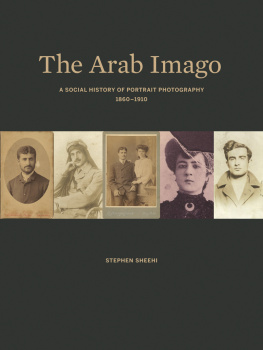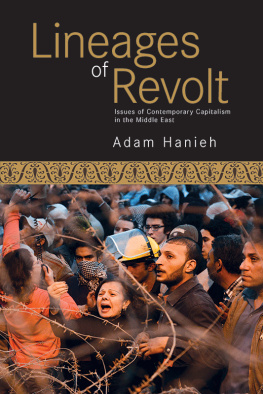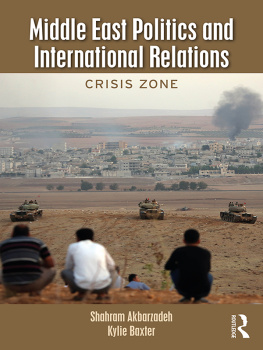THE ARAB IMAGO
The Arab
Imago
A SOCIAL HISTORY
OF PORTRAIT PHOTOGRAPHY,
18601910
Stephen Sheehi
Princeton University Press
Princeton and Oxford
Copyright 2016 by Princeton University Press
Published by Princeton University Press,
41 William Street, Princeton, New Jersey 08540
In the United Kingdom: Princeton University Press,
6 Oxford Street, Woodstock, Oxfordshire OX20 1TW
press.princeton.edu
Jacket illustrations: (front) left to right: Abdullah Frres, Garabed Effendi Yassayian, Istanbul, undated carte de visite, 10.4 6.4 cm.; Shoucair, Rauf Abd al-Hadi, With fond memory to my dear friend [illegible name], Sincerely Rauf Abd al-Hadi, October 20, 1917, postcard, 13.8 9.8 cm.; Massaoud Frres, Kassab and unidentified woman, Port Said, May 16, 1904, 12.4 8.2 cm.; unknown photographer, Faridah Habib, Cairo, ca. 19001910, fragment, print on paper; and portrait of Wahib Sheehi, courtesy of Stephen Sheehi; (spine) G. Saboungi, anonymous portrait, Beirut, cabinet card, 16.3 10.8 cm.; (back) left to right: G. Saboungi, unidentified European with medals, 1893, cabinet card, 16.3 10.8 cm.; G. Saboungi and G. Krikorian, anonymous portrait, Beirut, 188090, carte de visite, 10.5 6.3 cm.; Khalil Hawie, portrait of a young man named Kassab, Alexandria, 10.8 6.7 cm.; Alexandre and Joseph Kova, anonymous bridal portrait, Beirut, ca. 1900, carte de visite; and unknown photographer, Masis Bedrossian, 1920, portrait postcard, 13.9 8.9 cm.
All Rights Reserved
ISBN 978-0-691-15132-8
Library of Congress Cataloging-in-Publication Data
Sheehi, Stephen, 1967 author.
The Arab imago : a social history of portrait photography, 18601910 /
Stephen Sheehi.
pages cm
Includes bibliographical references and index.
ISBN 978-0-691-15132-8 (hardback : acid-free paper)
1. Portrait photographyMiddle EastHistory19th century. 2. PhotographySocial aspectsMiddle EastHistory 19th century. 3. Portrait photographyMiddle EastHistory20th century. 4. PhotographySocial aspectsMiddle EastHistory20th century. I. Title.
TR113.5.S54 2016
770.956dc23
2015030517
eISBN: 978-0-691-23535-6
R0
For You
Who have given me this book
With your love and faith.
Photography [fotografia]the writing of light, or otherwise known as al-taswir al-shamsi [sun-imaging]is a modern craft that has reached in these recent years a level of unsurpassed credibility. Many of al-Muqtatafs honorable readers like to approach its secrets through naked, theoretical science; others want to learn how to do the work itself. We wrote this article to fulfill both obligations.
SHAHIN MAKARIUS, AL-FOTOGRAFIA, al-Muqtataf 7 (188283)
ACKNOWLEDGMENTS
I am struck by how this project has enacted a projective identification with the topic itself. Like the portrait, the research holds so much history; it contains so many layers; it speaks and it remains silent of its own production. The book operates on multiple levels of identification and ideology and expresses both a personal interiority and a collective subjectivity. Yet, also like the portrait, multitudes lie outside of this manuscript; so much has not made its way in, so much sits adjacent to it staring from the outside. The project, let alone the book, holds a dear amount of emotional energy that lies far beyond its eccit. One thing that is certain undergirds the mass of material collected for this book and brings together the thousands of hours and tens of thousands of miles between four continents and numerous libraries, archives, and collections. This is the aid, friendship, generosity, patience, care, and love of so many people.
I could not have dared to start the Promethean task of excavating the vast uncharted terrain of Ottoman Arab photography without the help of archivists and librarians in Europe, North America, and the Middle East. I offer profound thanks to Yasmine Chamali and the Fouad Debbas Collection in Beirut, and Jeanette Sarouphim at the Institute of Palestine Studies in Beirut; Debbie Usher at Oxfords St. Antonys College Middle East Centre Archive; Joanne Bloom and Andras Riedlmayer at Harvards Fine Arts Library; Zeina Arida and the staff at the Arab Image Foundation; Tracy Schuster at the Getty Research Institute; Muhannad Salhi at the Library of Congresss African and Middle East Division; Jan Just Witkam in Leiden and Claude Sui at Reiss-Engelhorn-Museen in Mannheim. All of these archivists share an intricate and intimate knowledge of their collections, compounded with a generous spirit and eagerness to help. Likewise, I thank the staff at the American University of Beirut, the Lebanese National Archives in Beirut, Institut du Monde Arabe in Paris, the Mohammed Ali Foundation and Abbas Hilmi Collection at Durham University, and Dar al-Kalima in Bethlehem, along with Rachel Alma Lev and Paul Vester at the American Colony of Jerusalem, Constantia Nicolaides at the National Portrait Gallery in London, and Jesse Peers and Joe Struble at the George Eastman Legacy Collection at George Eastman House. Special thanks are due to Sura and Saeb Salam, His Excellency Prime Minister Tammam Salam, and Mr. Hallaq, the archivist for the Salam family collection, for facilitating several visits to their family archive. I would also like to thank my editors Lisa Hacken and Beth Gianfagna, who were professional, pleasant, thorough, and gentle. Particular thanks go to Princeton University Press, especially to Hanna Winarsky and Michelle Komie, who have been kind, responsive, helpful, and immeasurably patient, considering that completion of this book was interrupted by the loss of two hard drives, the publication of my book Islamophobia, and many more tribulations and blessings.
A massive number of photographs from institutional and personal collections in the Middle East and Europe did not make their way into this book, partially because copyright permissions were not given. For this reason, it is even more important to acknowledge that the images in this book have been reproduced with the permission of the Sadek, Saddic, Salem, and Rebeiz families in Ottawa, Philadelphia, and Beirut, respectively. Institutions that have permitted me to reproduce photographs in their collections are, in Lebanon, the Fouad Debbas Collection, the Institute of Palestine Studies, the Arab Image Foundation, the American University of Beirut, and the Lebanese National Archives; in Great Britain, the Middle East Centre Archive at St. Antonys College, University of Oxford, the National Portrait Gallery and the Mohamed Ali Foundation in London, and the Abbas Hilmi Collection at Durham University Library; in Cairo, the American University of Cairo; in Amman, the Khaled Shouman Foundation and Darat al-Funun; in Mannheim, Germany, the Reiss-Engelhorn-Museen; and in the United States, Harvard University Libraryespecially the Fine Arts Library, the Getty Research Institute in Los Angeles, the Zaidan Foundation in Bethesda, and the Library of Congress.
This book is indebted to the time and generosity of Muhammad Alwan, Isis Sadek, Gamil Sadek, and George Zaidan of the Zaidan Foundation, who generously shared their personal collections with me along with their invaluable knowledge. Richard Milosh in Australia was lavish in supplying me with an oral and written history of the fascinating Arakel Artinian and Studio Venus. A very special thanks goes to the tireless and unrecognized research on Louis Saboungi by zcan Geer in Istanbul, whose generosity, sincerity, and friendship have been overwhelming, and whose work on Louis Saboungi needs public recognition. Also, I thank Rogier Visser for access to his wonderful dissertation. My respects and thanks to the late and legendary Kemal Rebeiz for many early morning meetings and for providing me access to his archive as well as a volume of anecdotal information. Ola Seif, curator of the Photography Collection at the American University of Cairo, deserves an exceptional thanks and acknowledgment. She is not only the most helpful, informed, untapped resource on photography in Egypt, but also, her generosity, kindness, and friendship have taught me much personally and professionally and undoubtedly have enriched this book.









